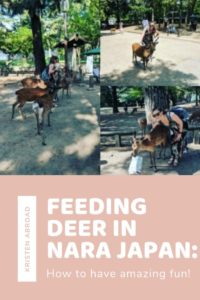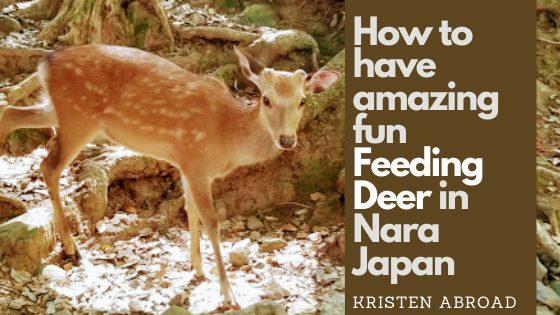You’ve probably heard about feeding deer in Nara Park while researching things to do in Japan. I’m sorry, Nara. The deer in Nara might outshine the UNESCO World Heritage sites. There are Sika deer on Assateague Island on the Eastern Shore of Virginia where I spent many a summer growing up. However, I’ve only ever seen them in the distance until coming to Nara. Feeding deer in Nara Park is definitely an experience to be had.
Side note: Sika is the English spelling of the word for deer in Japanese (鹿), so if you say sika deer, it’s actually saying “deer deer”. Shika or Sika (depending on how you romanize the word) are native to Japan and are sometimes be referred to as “Japanese deer”.
- How to find Nara Park (奈良公園)
- Why are there deer in Nara anyway?
- How many deer are in Nara Park?
- What do you feed the deer in Nara?
- Where to find the deer in Nara
- Tips for feeding deer in Nara
- Bowing deer in Nara
- Warning: Wild animals Ahead
- Deer events in Nara
- 鹿寄せ Shikayose, Deer Calling
- See baby deer at Rokuen!
- 鹿の角切り Deer Antler Cutting Ceremony
- Join the Nara Deer Protection Society
- Getting to Nara
- Pin this for later
[Editor’s Note: This post was originally published in July of 2018 and has been updated for freshness, accuracy, and comprehensiveness.]
Disclosure: Kristenabroad.com is a participant in the Amazon Services LLC Associates Program and other affiliate programs. For some links to products or services in this article, I may earn a small commission by you using my link. The price for you is not affected.
How to find Nara Park (奈良公園)
A quick 5-minute walk from Kintetsu-Nara Station will get you to the edge of Nara Park. How do you know you’ve reached it? The deer!
Nara Park has been designated a 名勝 (めいしょう) or scenic park since 1922. One of the oldest parks in Japan, Nara Park opened in 1880. Make sure you bring your walking shoes (I love my Tevas), as, at over 500 hectares, you’ll be doing a lot of walking.
Speaking of, do you like to track your steps while you are traveling? My favorite fitness watch is the Garmin Fenix 5S. It can hook to my smartphone, has built-in GPS for running, and the battery lasts nearly a week.
Nara Park is huge and you can spend a lot of time walking around and seeing the different herds, plus it leads you to all of the UNESCO World Heritage sites, including Todaiji Great Buddha.
Like festivals? With so many shrines and temples (and the deer) co-located in Nara Park, there’s nearly always a festival going on.
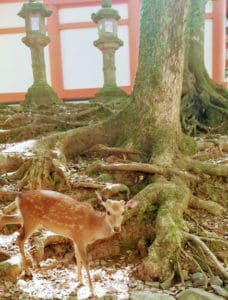
Why are there deer in Nara anyway?
The capital of Japan was moved to Nara in the 700s and thus started the Nara Era. The ruling family (Fujiwara) built the Kasuga Taisha (春日大社, Kasuga Grand Shrine) as their tutelary shrine (a Shinto shrine meant to protect the area).
There is a story that the first of the shrine’s four deities came riding over on a white deer in 768. So for over 1000 years, the deer in Nara have been considered sacred.
So much so that it apparently used to be an offense punishable by death if you killed one of them! While that hasn’t happened in many years, you can still get thrown in jail over it.
Nowadays the deer of Nara (奈良のしか) are designated as 天然記念物 (てんねんきねんぶつ) or natural monuments by the Agency of Cultural Affairs.
How many deer are in Nara Park?
As of 2019, there are 1,388 deer in Nara. The send a small army of people out to survey them every year which sounds fun but also, I’d be worried I’d accidentally double count some!
Every year some of the deer die in car accidents so if you choose to drive, watch out for the deer! They are tiny, the males only get up to about 85 cm at their shoulder (or about 3 feet converting to English units).
And while they sometimes get hit by cars, they also seem to understand the concept of a crosswalk and pedestrian signals! Oddest thing to see a deer in Nara queuing to cross the street with everyone else.
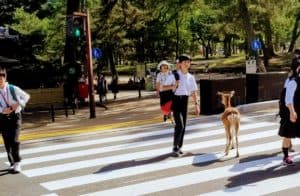
What do you feed the deer in Nara?
The sika diet mainly consists of a grass called ノシバ (noshiba) which can be found all over Nara Park and other small plants. However, they love 鹿せんべい (shika senbei) or deer crackers!
This snack is made out of rice bran without any sugar or spices added to it so it’s edible for the deer in Nara, but they shouldn’t be having tons of it I’m sure. That doesn’t stop some of them from hanging out by where they are sold!
There are small carts scattered throughout Nara Park where you can find crackers for sale. Last time I was there it cost 150円 (or about $1.50 USD) for a stack of them. I can’t imagine the price changes often.
Part of the proceeds for buying deer crackers goes to conservation efforts.
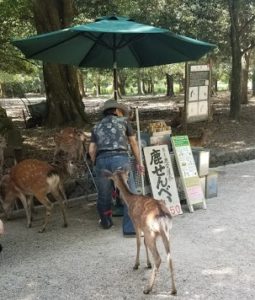
Where to find the deer in Nara
While the stands aren’t everywhere (remember this is a big park!), the deer most certainly are and you’ll find them in fields, in the woods, blocking your walking path to Todaiji Big Buddha…
You get my point. But because the senbei stands aren’t everywhere, I suggest you stock up in case you run into some deer and you aren’t near one of the stands.
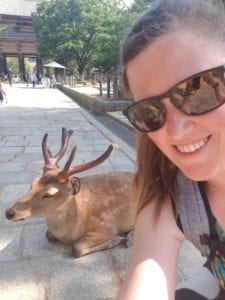
Tips for feeding deer in Nara
Every year many tourists get hurt so the cracker stands started to include directions on how to properly feed the deer in Nara. The signs are in Chinese, English, and Japanese but here’s what to expect.
- Make sure you watch any small children. I feel like this is self-explanatory. The deer are a small breed but they are still powerful. They nearly knocked me down on several occasions!
- Don’t taunt the deer while feeding them. I.e. don’t try and give them a treat and then take it away (More on how to “properly” do that in a minute). They’ll just get mad and you’ll add to the statistics of people being hurt by them.
- The deer are sneaky, watch out for others nearby. They may come to surprise you if they see you feeding their friends.
- Watch your belongings, one of the deer definitely tried to run off with my camera bag! This is especially true if you took the above advice and have some crackers in your bag!
- Only feed them the senbei (crackers). People-food (or plastic, heaven forbid) can be deadly to these little guys.
- When you are out of crackers, raise your hands so the deer can see you don’t have anymore. Else you might get nipped!
Speaking of nipping, Japan is very strict about bringing animals into their country and as such is rabies-free. There also haven’t been any other infectious diseases transmitted so If you are bitten, you don’t need to worry so much.
Bowing deer in Nara
If you thought the deer’s ability to properly cross the road was odd, how they go about getting treats might surprise you even more.
They bow.
As if that wasn’t the most Japanese thing of them to do.
The trick is If you put the crackers over their heads, they’ll do a little bow, and you hand them the treat for them to eat. It’s adorably cute and fun.
[Disclaimer: I don’t normally condone feeding wild animals, this is definitely a special case and a way to keep the herds from causing a nuisance! Japan does similar things with large populations of monkeys.]
Warning: Wild animals Ahead
You’ll see signs around Nara Park to remind you that the deer in Nara are in fact wild animals. They are kind of adorable with the little cartoons biting, kicking, butting, and knocking people over on them.
Please don’t antagonize the poor things, they aren’t meant to be chased or hit or ridden (I’m sure someone has tried to do that with a child). As they are designated natural monuments, you can be punished for violating the Cultural Property Protection Law if you do!
I suggest feeding deer in Nara in areas where there aren’t herds of them. I made that rookie mistake because I was super excited and didn’t want to wait. End result? Slight mobbing by the deer and a few nips. Yes, they bite. No damage was done but something to watch out for.
You’ll want to watch what time of year you are there as well. The females are very protective of their fawns in Spring time and the males can get aggressive when they are trying to find a mate in the fall.
Deer events in Nara
If feeding deer in Nara wasn’t enough fun for you, there are three different events throughout the year to keep you entertained as well!
鹿寄せ Shikayose, Deer Calling
Scattered throughout the year, you have opportunities to see an event called 鹿寄せ(shikayose) or deer calling. It’s been going on since 1892 in which someone on a french horn calls out to the deer and they come scurrying in from all over to get some acorns.
Why? If someone knows, they aren’t talking!
If you can’t make one of the set days you also have the opportunity to reserve your own private screening up to a year in advance, for a cool 21,000 yen (about $210 USD). The money goes to the conservation efforts.
See baby deer at Rokuen!
Rokuen (鹿苑) is a small sheltered area that they move the mother deer to with their fawns to keep them safe after they are born.
In June, you can go see them for yourself! At the event you can get special deer treats to feed them as well as acorns.
鹿の角切り Deer Antler Cutting Ceremony
The 鹿の角切り or Deer Antler Cutting Ceremony is held every year normally around the 2nd or 3rd week of October. It originally started in 1672, and with a brief hiatus in Meiji Era has been going on every since.
You know how I said the male deer get a little aggressive when they are getting frisky? People apparently were getting injured so to help out, this event ceremoniously cuts their antlers.
Don’t worry, that doesn’t hurt them. Antlers are kind of like finger nails, no nerves or blood vessels.
The event if you happen to be there costs 1,000 yen for adults or 500 yen for children. Unless you are in the Nara Deer Protection Society and get in for free.
Join the Nara Deer Protection Society
The Nara Deer Protection Society (奈良の鹿愛護会) is supported through membership, so if deer are your thing, here’s a charity for you! Membership comes with a member card, a bi-yearly magazine (in Japanese), free admission into the two yearly deer events, as well as entrance into many of the local attractions in Nara for free – including Todaiji Great Buddha!
While you can sign up at anytime, membership follows the Japanese school year of April to March and will run you about 5000 yen ($50 USD). But, if you want to contribute to the protection of the deer in Nara, plus have your entrances covered, it’s there for you.
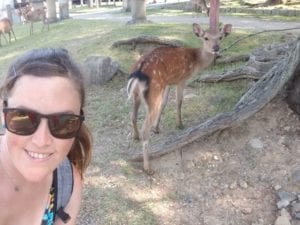
Getting to Nara
Taking the train from Kyoto to the Kintetsu-Nara Station will take you about 35 minutes depending on which train you get on. Look out for when the Kintetsu Limited Express runs as it will get you there without a transfer.
While Kintetsu-Nara Station is the closest to the park so you can feed the deer in Nara right away, you will not be able to use your JR Rail Pass for that line and will need to have some money on your IC Card. The ride as of writing this is 640 yen one way.
If you are looking to use your JR Rail Pass, you can head to Nara Station and have a little bit of a walk. However, it’s a much longer train ride. Many people do Nara as a day trip from Kyoto so I suggest Kintetsu-Nara so you get the most out of your trip.
Coming from Tokyo? Shinkansen down to Kyoto Station and follow the above!
Didn’t get enough deer time in? There are also a bunch of deer in Miyajima!
Pin this for later
I hope you have an awesome time with whichever deer event you get to experience.
One final tip – if you follow my advice and stopped by the tourist information center for some local maps, beware! If you are looking at it and deer are by, they may try and grab it! I was glad I accidentally grabbed two!
